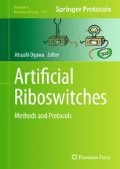Abstract
Riboswitches are naturally occurring RNA-based genetic switches that control gene expression in response to the binding of small-molecule ligands, typically through modulation of transcription or translation. Their simple mechanism of action and the expanding diversity of riboswitch classes make them attractive targets for the development of novel gene expression tools. The essential first step in realizing this potential is to generate artificial riboswitches that respond to nonnatural, synthetic ligands, thereby avoiding disruption of normal cellular function. Here we describe a strategy for engineering orthogonally selective riboswitches based on natural switches. The approach begins with saturation mutagenesis of the ligand-binding pocket of a naturally occurring riboswitch to generate a library of riboswitch mutants. These mutants are then screened in vivo against a synthetic compound library to identify functional riboswitch–ligand combinations. Promising riboswitch–ligand pairs are then further characterized both in vivo and in vitro. Using this method, a series of artificial riboswitches can be generated that are versatile synthetic biology tools for use in protein production, gene functional analysis, metabolic engineering, and other biotechnological applications.
Access this chapter
Tax calculation will be finalised at checkout
Purchases are for personal use only
References
Breaker RR (2011) Prospects for riboswitch discovery and analysis. Mol Cell 43:867–879
Serganov A, Nudler E (2012) A decade of riboswitches. Cell 152:17–24
Barrick JE, Breaker RR (2007) The distributions, mechanisms, and structures of metabolite-binding riboswitches. Genome Biol 8:R239
Codrea V, Hayner M, Hall B et al (2010) In vitro selection of RNA aptamers to a small molecule target. Curr Protoc Nucleic Acid Chem Chapter 9:Unit 9.5.1–5.23
Sharma V, Nomura Y, Yokobayashi Y (2008) Engineering complex riboswitch regulation by dual genetic selection. J Am Chem Soc 130:16310–16315
Lynch SA, Desai SK, Sajja HK et al (2007) A high-throughput screen for synthetic riboswitches reveals mechanistic insights into their function. Chem Biol 14:173–184
Topp S, Gallivan JP (2008) Random walks to synthetic riboswitches-a high-throughput selection based on cell motility. Chembiochem 9:210–213
Fowler CC, Brown ED, Li Y (2008) A FACS-based approach to engineering artificial riboswitches. Chembiochem 9:1906–1911
Lynch SA, Gallivan JP (2009) A flow cytometry-based screen for synthetic riboswitches. Nucleic Acids Res 37:184–192
Dixon N, Duncan JN, Geerlings T et al (2010) Reengineering orthogonally selective riboswitches. Proc Natl Acad Sci U S A 107:2830–2835
Desai SK, Gallivan JP (2004) Genetic screens and selections for small molecules based on a synthetic riboswitch that activates protein translation. J Am Chem Soc 126:13247–13254
Sinha J, Reyes SJ, Gallivan JP (2010) Reprogramming bacteria to seek and destroy an herbicide. Nat Chem Biol 6:464–470
Topp S, Reynoso CMK, Seeliger JC et al (2010) Synthetic riboswitches that induce gene expression in diverse bacterial species. Appl Environ Microbiol 76:7881–7884
Reynoso CMK, Miller MA, Bina JE et al (2012) Riboswitches for intracellular study of genes involved in Francisella pathogenesis. MBio 3:e00253–00212
Dixon N, Robinson CJ, Geerlings T et al (2012) Orthogonal riboswitches for tuneable coexpression in bacteria. Angew Chem Int Ed 51:3620–3624
Suess B, Fink B, Berens C et al (2004) A theophylline responsive riboswitch based on helix slipping controls gene expression in vivo. Nucleic Acids Res 32:1610–1614
Wachsmuth M, Findeiß S, Weissheimer N et al (2013) De novo design of a synthetic riboswitch that regulates transcription termination. Nucleic Acids Res 41:2541–2551
Link KH, Breaker RR (2009) Engineering ligand-responsive gene-control elements: lessons learned from natural riboswitches. Gene Ther 16:1189–1201
Carothers JM, Oestreich SC, Szostak JW (2006) Aptamers selected for higher-affinity binding are not more specific for the target ligand. J Am Chem Soc 128:7929–7937
Johnson JE Jr, Reyes FE, Polaski JT et al (2012) B12 cofactors directly stabilize an mRNA regulatory switch. Nature 492:133–137
Peselis A, Serganov A (2012) Structural insights into ligand binding and gene expression control by an adenosylcobalamin riboswitch. Nat Struct Mol Biol 19:1182–1184
Serganov A, Patel DJ (2012) Molecular recognition and function of riboswitches. Curr Opin Struct Biol 22:279–286
Uhlenbeck OC (1995) Keeping RNA happy. RNA 1:4–6
Gilbert SD, Batey RT (2009) Monitoring RNA-ligand interactions using isothermal titration calorimetry. Methods Mol Biol 540:97–114
Salim NN, Feig AL (2009) Isothermal titration calorimetry of RNA. Methods 47:198–205
Pikovskaya O, Serganov AA, Polonskaia A et al (2009) Preparation and crystallization of riboswitch-ligand complexes. Methods Mol Biol 540:115–128
Edwards AL, Garst AD, Batey RT (2009) Determining structures of RNA aptamers and riboswitches by X-ray crystallography. Methods Mol Biol 535:135–163
Nomura Y, Yokobayashi Y (2007) Reengineering a natural riboswitch by dual genetic selection. J Am Chem Soc 129:13814–13815
Muranaka N, Sharma V, Nomura Y et al (2009) An efficient platform for genetic selection and screening of gene switches in Escherichia coli. Nucleic Acids Res 37:e39
Muranaka N, Abe K, Yokobayashi Y (2009) Mechanism-guided library design and dual genetic selection of synthetic OFF riboswitches. Chembiochem 10:2375–2381
He B, Rong M, Lyakhov D et al (1997) Rapid mutagenesis and purification of phage RNA polymerases. Protein Expr Purif 9:142–151
Chronopoulou EG, Labrou NE (2011) Site-saturation mutagenesis: a powerful tool for structure-based design of combinatorial mutation libraries. Curr Protoc Protein Sci Chapter 26:Unit 26.6
Regulski EE, Breaker RR (2008) In-line probing analysis of riboswitches. Methods Mol Biol 419:53–67
Wakeman CA, Winkler WC (2009) Analysis of the RNA backbone: structural analysis of riboswitches by in-line probing and selective 2′-hydroxyl acylation and primer extension. Methods Mol Biol 540:173–191
Mandal M, Breaker RR (2004) Adenine riboswitches and gene activation by disruption of a transcription terminator. Nat Struct Mol Biol 11:29–35
Myszka DG, Abdiche YN, Arisaka F et al (2003) The ABRF-MIRG‘02 study: assembly state, thermodynamic, and kinetic analysis of an enzyme/inhibitor interaction. J Biomol Tech 14:247–269
Author information
Authors and Affiliations
Editor information
Editors and Affiliations
Rights and permissions
Copyright information
© 2014 Springer Science+Business Media New York
About this protocol
Cite this protocol
Vincent, H.A., Robinson, C.J., Wu, MC., Dixon, N., Micklefield, J. (2014). Generation of Orthogonally Selective Bacterial Riboswitches by Targeted Mutagenesis and In Vivo Screening. In: Ogawa, A. (eds) Artificial Riboswitches. Methods in Molecular Biology, vol 1111. Humana Press, Totowa, NJ. https://doi.org/10.1007/978-1-62703-755-6_8
Download citation
DOI: https://doi.org/10.1007/978-1-62703-755-6_8
Published:
Publisher Name: Humana Press, Totowa, NJ
Print ISBN: 978-1-62703-754-9
Online ISBN: 978-1-62703-755-6
eBook Packages: Springer Protocols

